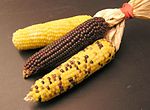- Flint corn
-
Flint corn, (Zea mays indurata; also known in most countries as Indian corn or sometimes calico corn) is the same species as, but a different variant of maize (var. Linnaeus).[1] Because each kernel has a hard outer layer to protect the soft endosperm, it is likened to being hard as flint; hence the name.[2]
With less soft starch than dent corn (Zea mays indentata), it is too hard to bear concavities ("indentations").[3][clarification needed] This is one of the three types of corn cultivated by Native Americans, both in New England and across the northern tier, including by tribes such as the Pawnee on the Great Plains. Archeologists have found evidence of such corn cultivation by the Pawnee and others since at least 1250 AD.[4] Cultivation of corn occurred hundreds of years earlier among the Mississippian culture people, whose civilization arose based on population density and trade because of surplus corn crops.
Contents
Distinctive traits
Because flint corn has a very low water content it is more resistant to freezing than other vegetables. It was the only Vermont crop to survive New England's infamous "Year Without a Summer" of 1816.[5]
Coloration
Flint corn has different colors, and it is natural for corn. Single-coloured varieties are bred by human.[6] Like the Linnaeus variant of maize, any kernel may contain the yellow pigment zeaxanthin but at more varying concentrations.[7]
Uses
Popcorn (Zea mays everta, "corn turned inside out") is considered a variant of this type. It has a hard, slightly translucent kernel.[8]
Flint corn is also the type of corn preferred for making hominy, a staple food in the Americas since pre-Columbian times.
The flintcorn cultivars that have large proportions of kernels with hues outside the yellow range are primarily used ornamentally, notably as part of Thanksgiving decorations in the United States. They are often called either "ornamental corn" or "Indian corn", although each of those names has other meanings as well.
References
- ^ jugalbandi.info Indian Corn
- ^ "Seeds of Change Garden". www.mnh.si.edu. http://www.mnh.si.edu/archives/garden/history/corn.html. Retrieved 2010-03-17.
- ^ nmsu.edu Blue Corn Unique to American Southwest
- ^ Gene Weltfish, The Lost Universe: Pawnee Life and Culture, Lincoln, NE: University of Nebraska Press, 1965; reprint 1977, pp.4-8, accessed 16 Dec 2009
- ^ slowfoodusa.org Roy’s Calais flint corn. Retrieved August 2011
- ^ wonderquest.com Indian corn
- ^ mnh.si.edu What kinds of corn are there?
- ^ New Oxford American Dictionary
Maize (corn) Varieties Baby · Blue · Field · Flint · MON 810 · MON 863 · Quality Protein Maize · Shoepeg · Sweet · Transgenic maize · Waxy · Bolivia varieties · Ecuador varieties · Italian varieties · Sweetcorn varieties
Parts Processing Pathology Corn-based products Raw materials Beverages Dishes Bread · Cookie · Corn flakes · Corn on the cob · Fufu · Grits · Hominy · Mazamorra · Mush · Pap · Piki · Polenta · Popcorn · Pudding corn · Sadza · Shawnee cakeCorn syrup Glucose syrup · High-fructose corn syrup (Health effects · Public relations) · High maltose corn syrupNon-food Categories:- Maize varieties
- Agriculture stubs
Wikimedia Foundation. 2010.
